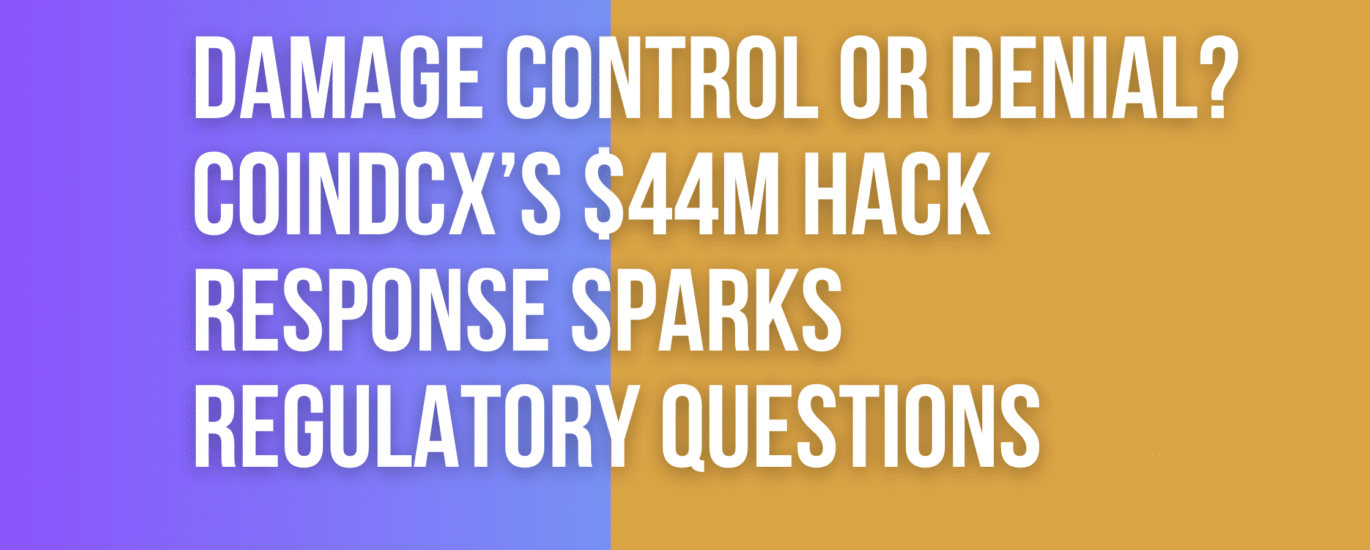In the world of crypto, transparency is everything. One small misstep—or worse, a cover-up—can dismantle years of trust built with users. And that’s exactly what’s unfolding with CoinDCX, one of India’s most prominent crypto exchanges.
After losing $44 million in a recent exploit, CoinDCX’s leadership chose to label the incident a “security audit.” Not a hack. Not a breach. A security audit.
The crypto community isn’t buying it. Especially when compared to how WazirX, once under fire for its own $230 million custody crisis in 2024, has taken a radically different approach—open communication, court-backed recovery, and putting users first.
Let’s break down what went wrong at CoinDCX, why it matters for regulators, and why WazirX is now (ironically) setting a better example.
What Happened at CoinDCX?
On July 19, 2025, renowned blockchain investigator ZachXBT published a report exposing that $44 million had been siphoned from CoinDCX’s wallets. These weren’t one-time transfers—they were part of a pattern of suspicious activity, tracked using on-chain data.
Instead of issuing an immediate warning or incident report, CoinDCX stayed silent.
Only when the post gained traction did they confirm the exploit, with co-founder Neeraj Khandelwal tweeting that this was part of a “security audit.” That response was widely ridiculed across the crypto world.
Audit or Avoidance?
Let’s be clear:
A security audit is a proactive test done by white-hat hackers or internal teams to assess vulnerabilities.
A hack is an unauthorized attack where funds are stolen.
Calling one the other is not just misleading—it’s deceptive.
CoinDCX’s wordplay isn’t clever PR. It’s a red flag.
It shows a lack of willingness to own up, take responsibility, and treat users with the respect they deserve. Their vague statement didn’t include details about:
-
When the breach was detected
-
How much was lost
-
Whether user funds were impacted
-
What security measures are now in place
-
If the attacker is known or being pursued
Instead of answers, users got spin.
Why Regulators Should Be Worried
CoinDCX’s handling of this breach has reopened a crucial debate: Who protects the Indian crypto investor?
As of now, there’s no SEBI-equivalent watchdog enforcing:
-
Mandatory breach disclosures
-
Standardized user compensation frameworks
-
Proof-of-reserves and fund segregation norms
That means platforms can suffer a loss, keep users in the dark, and pretend all is well—unless someone like ZachXBT exposes them.
This case highlights the regulatory vacuum in which Indian crypto exchanges operate. It’s a Wild West—and CoinDCX’s response just made that more obvious.
In Contrast: What WazirX Got (Surprisingly) Right
Let’s rewind to July 2024, when WazirX faced a $230M crisis due to a breach at its custody partner, Zettai. It wasn’t pretty. User withdrawals were frozen. Angry tweets flew. And the platform’s future looked bleak.
But here’s what they did right, in hindsight:
✅ Acknowledgement
WazirX publicly confirmed the breach shortly after internal investigation and legal consultations. No word games. No hiding.
✅ Legal Path to Repayment
Instead of ducking accountability, they pursued a court-backed repayment scheme through the Singapore High Court. As of July 2025, the court has allowed a revote on the restructuring plan, giving users a voice.
✅ User-Centric Communication
From timelines and FAQs to blog updates and Twitter AMAs, WazirX made sure users stayed in the loop—even when the news wasn’t good. Transparency wasn’t perfect, but it was miles ahead of CoinDCX’s playbook.
✅ Collaborating with Creditors
WazirX encouraged users to register as creditors and vote on restructuring terms, rather than unilaterally deciding how to “handle” their funds.
That’s not just crisis management. That’s respect.
CoinDCX’s “No Users Affected” Claim: Where’s the Proof?
CoinDCX insists that “no user funds were impacted,” and that only “internal funds” were lost. But:
-
Where is the on-chain proof of fund segregation?
-
Why didn’t they publish a proof-of-reserves to validate the claim?
-
Why not announce a third-party audit or independent investigation?
Without evidence, these assurances are meaningless—especially in an industry built on transparency and trustless systems.
When WazirX made similar claims, they were backed by legal documents, court filings, and a creditor portal. CoinDCX, on the other hand, expects users to just believe them.
In crypto, trust must be verified. Not assumed.
A Wake-Up Call for Indian Exchanges
This incident should be a turning point—not just for CoinDCX, but for the entire Indian crypto ecosystem. It’s time to raise the bar.
Here’s what every exchange must adopt immediately:
-
Mandatory Breach Disclosures within 48 hours
-
Proof-of-Reserves published quarterly
-
User Compensation Protocols reviewed by third parties
-
Public Incident Reports after any exploit
-
Open Communication Channels (especially during crises)
If CoinDCX won’t do it, regulators should make them.
Conclusion: Words Matter, So Does Integrity
CoinDCX’s decision to downplay a $44M hack as a “security audit” isn’t just bad optics—it’s a serious failure in duty of care. And it’s especially glaring when compared to WazirX, a platform that, despite its past troubles, is slowly earning back user trust through transparency, legal accountability, and proactive engagement.
Crypto in India is at a crossroads. One path leads to a more responsible, investor-first future. The other leads to shady disclaimers, delayed disclosures, and shattered confidence.
CoinDCX had a chance to show leadership. Instead, they played semantics.
Now, the users—and regulators—are demanding better.






